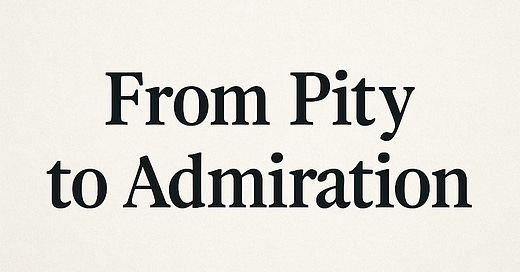From Pity to Admiration: Reframing How We See Disability
From the THX Series Hub: Disability, Autism & THX
Most people don’t want to be pitied. And most disabled people don’t want to be admired for surviving systems that weren’t built for them. But admiration—when rightly understood—isn’t pity. It’s not inspiration porn. And it’s not sympathy.
It’s recognition. It’s respect. It’s seeing skill, goodness, awe, and resilience—and responding with trust, not sentimentality.
This is the promise of the Admiration Equation: that when someone consistently exceeds the limitations of a broken system, not for glory, but for life—that’s not a tragedy or a miracle. It’s a truth we’ve failed to design for.
What the Admiration Equation Actually Means
When I was younger, I felt like a burden. I didn’t have a word for the pain that came and went unpredictably, or for the exhaustion that seemed to shadow me in classrooms, on playgrounds, and later, in jobs. I was told to toughen up. To be more like the others. To not make things harder than they already were.
What people saw as weakness, I now understand as survival. I became good at hiding what hurt. I learned to be useful, to exceed expectations, to do more so that I wouldn’t be seen as “less.”
What I longed for wasn't pity. It was recognition. That I was already trying hard. That I was already enough.
That’s why the Admiration Equation matters to me—not as a theory, but as a reframe for how we see one another.
The Admiration Equation is built on four core ingredients:
Skill — Not just talent, but practiced, often invisible mastery
Goodness — Moral clarity and compassion in the face of adversity
Awe — A response to courage, creativity, or perseverance that exceeds expectation
Gratitude — Feeling honored that someone shares their story, effort, or presence with you
When people experience these ingredients in unexpected, multi-sensory, and emotionally positive micro-moments, admiration is born.
It’s not performative. It’s not passive. It’s transformational.
Why Disabled People Deserve Admiration—not Pity
Because they’re often their own case managers, researchers, advocates, project managers, and emotional processors—all while navigating physical pain, social stigma, and inaccessible systems.
Because a disabled person might do more before breakfast—mentally, emotionally, and logistically—than someone else does all week.
Because they’ve learned to build joy in the margins. To design safety in the absence of security. To persist not to prove a point, but to stay connected to life.
And they do this not for recognition—but for survival, for their families, and for a life that still matters even when the system fails.
What You Can Do Instead of Pity
Shift your gaze from outcome to effort. Don’t ask what someone can’t do. Ask what they do anyway.
Replace compliments with curiosity. If you’re moved by someone’s strength, ask what it cost them. Then ask what they need.
Notice the system. If you’re impressed by someone’s “success,” ask: why did the system make that success so difficult?
Final Thought
Admiration, when done right, invites us to design better. To build systems where resilience isn’t a requirement for basic dignity.
If someone’s life leaves you in awe, don’t stop at the feeling.
Ask what role you play in making that awe less necessary.
Then build forward.




